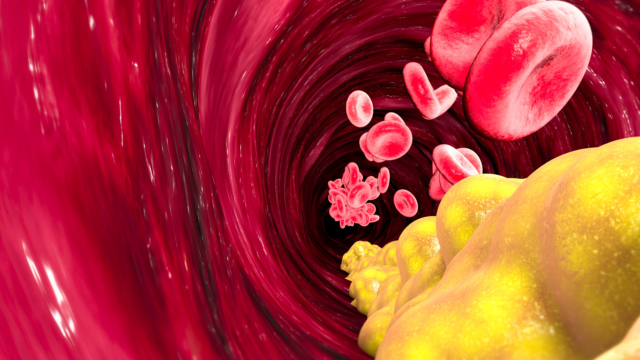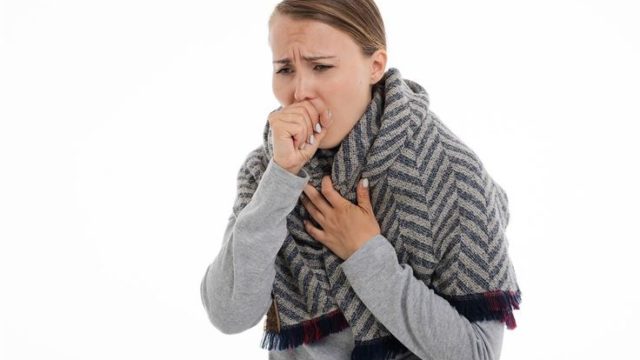FTC disclaimer: This post may contains affiliate links and we will be compensated if you click on a link and make a purchase.
Lung cancer takes over 1.8 million lives every year. It’s the top cause of cancer deaths worldwide. This shows how important it is to know more about this disease. Learning about symptoms, causes, and treatments can help you or your loved ones fight it.
Lung cancer is mainly split into two types: non-small cell lung cancer (NSCLC) and small cell lung cancer (SCLC). Knowing the type helps pick the best treatment. Early lung cancer might not show symptoms. But as it grows, signs like a long cough, coughing up blood, chest pain, and shortness of breath appear. Spotting these signs early is key to catching the disease and treating it well.
Key Takeaways
- Lung cancer is the leading cause of cancer-related deaths worldwide.
- Lung cancer can be divided into two main types: non-small cell lung cancer (NSCLC) and small cell lung cancer (SCLC).
- Early-stage lung cancer may not exhibit any symptoms, but as the disease progresses, common signs can include a persistent cough, coughing up blood, chest pain, shortness of breath, and unexplained weight loss.
- Recognizing lung cancer symptoms is crucial for early detection and effective treatment.
- Advancements in lung cancer treatment, including surgery, radiation therapy, chemotherapy, targeted therapy, and immunotherapy, offer hope for improved outcomes.
What is Lung Cancer?
Lung cancer starts in the lungs’ cells. It’s the top cause of cancer deaths worldwide. It’s split into two main types: non-small cell lung cancer (NSCLC) and small cell lung cancer (SCLC).
Types of Lung Cancer
NSCLC makes up 80-85% of lung cancers. It includes squamous cell carcinoma, adenocarcinoma, and large cell carcinoma. Adenocarcinoma is the most common NSCLC type. Squamous cell carcinoma is often linked to smoking. Large cell carcinoma grows and spreads fast.
SCLC is less common, making up 10-15% of lung cancers. Lung carcinoid tumors are rare, growing slowly. Other rare types include adenoid cystic carcinomas and sarcomas.
Causes of Lung Cancer
Smoking is the main cause of lung cancer. It damages lung cells, leading to cancer. Other risks include secondhand smoke, radon gas, asbestos, and family history. Living in polluted areas also raises lung cancer risk.
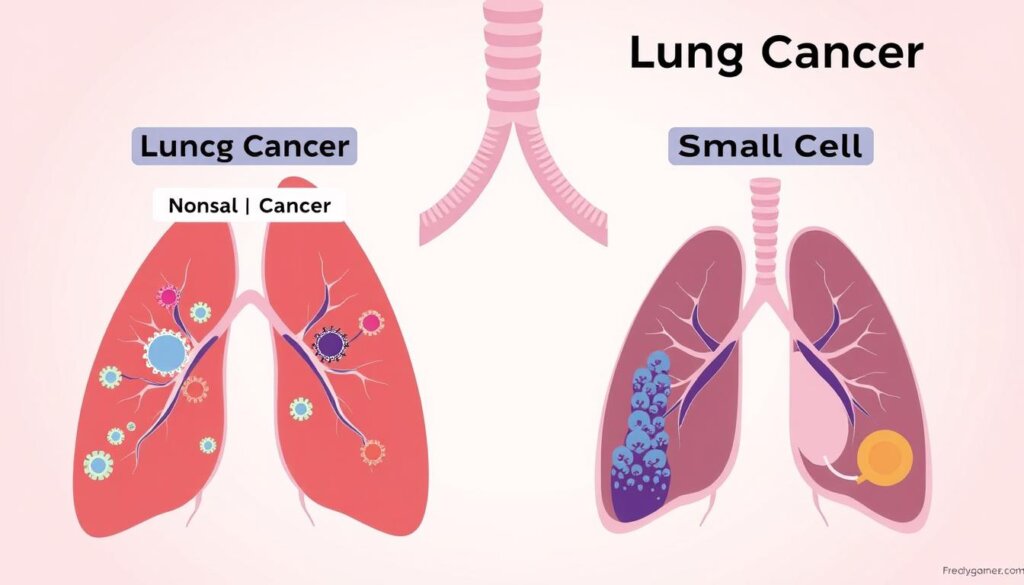
“For most lung cancer patients, existing treatments do not cure the cancer.”
Lung Cancer Symptoms
Lung cancer symptoms can be hard to spot early. Some people with lung cancer may not feel any symptoms at first. But as the disease gets worse, symptoms start to show up.
These symptoms include a cough that won’t go away, coughing up blood or rust-colored sputum, and chest pain. You might also feel hoarse, lose your appetite, or lose weight without trying. Shortness of breath and frequent lung infections are also signs.
If lung cancer spreads, it can cause more symptoms. These include bone pain, headaches, changes in the nervous system, and jaundice. It’s key to remember that these symptoms can also mean other, less serious issues. So, seeing a doctor is very important for the right diagnosis and treatment.
Spotting lung cancer early is vital. It means you might have more treatment options. Symptoms like these are often mistaken for the common cold or flu. But it’s crucial to watch for any signs that don’t go away or get worse.
Even if lung cancer doesn’t show obvious symptoms early on, knowing the signs is key. Getting medical help quickly can greatly change the disease’s course.
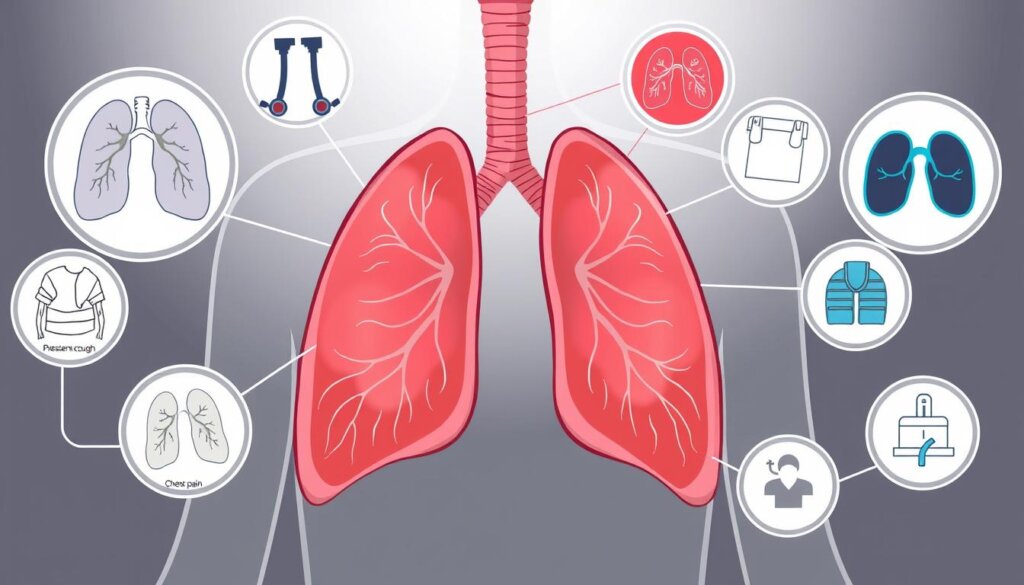
The lung cancer symptoms you feel can depend on the disease’s type and stage. For example, advanced lung cancer can lead to severe symptoms. These include constant fever, unexplained weight loss, weakness, neurological changes, and bone pain.
If you or someone you love is showing signs of lung cancer, get medical help right away. Early detection and treatment can greatly improve your chances of a good outcome.
Risk Factors for Lung Cancer
Lung cancer is a serious health concern. Knowing the risk factors is key for prevention and early detection. Smoking is the main risk factor both for those who smoke and those exposed to secondhand smoke.
About 80% of lung cancer deaths are from smoking. This number is even higher for small-cell lung cancer. Secondhand smoke is also a big risk, being the third most common cause in the United States.
Smoking and Secondhand Smoke
The risk of lung cancer goes up with more cigarettes and longer smoking. Quitting smoking can greatly lower lung cancer risk, even after many years. People who smoke are 15 to 30 times more likely to get lung cancer than non-smokers.
Other Risk Factors
There are other risk factors for lung cancer besides smoking. Radon gas is a big risk, especially for non-smokers. It causes about 21,000 lung cancer deaths in the U.S. each year, with 10% of these being non-smokers.
Working with harmful substances like asbestos and arsenic also raises lung cancer risk. Other risks include radiation therapy, family history of lung cancer, and air pollution. High levels of arsenic in water and beta-carotene supplements can also increase risk.
The link between smoking marijuana and lung cancer is unclear due to limited research. E-cigarettes can cause lung damage, but their effect on lung cancer is still being studied.
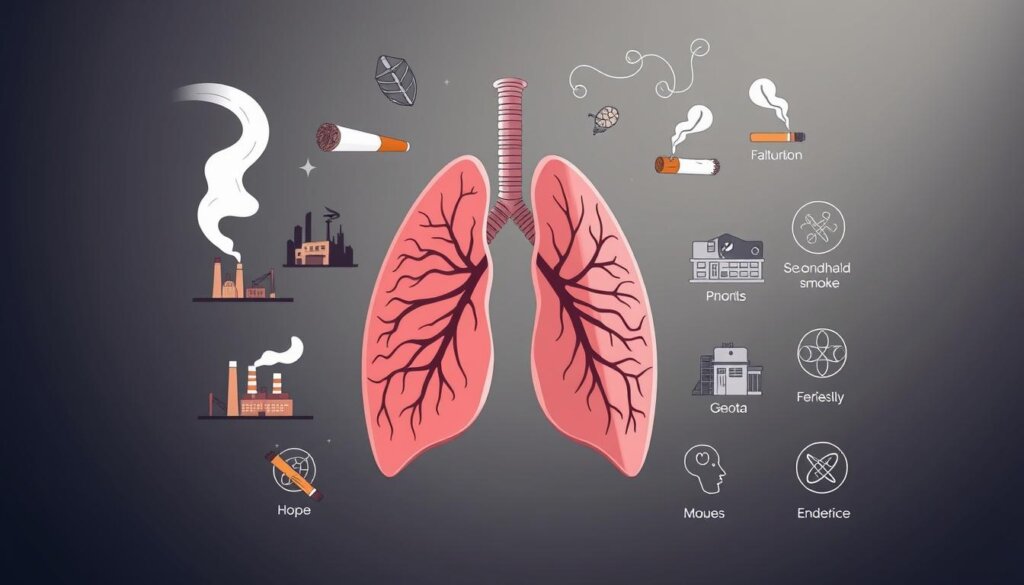
Knowing these risk factors helps people make better health choices. They can take steps to lower their lung cancer risk. Regular health checks and screenings can also help find lung cancer early, improving treatment chances.
Lung Cancer Diagnosis
Diagnosing lung cancer takes a few steps. It starts with a medical history and physical exam. Then, imaging tests like chest X-rays and CT scans are used to find tumors. These tests show how big the tumors are and if they’ve spread.
For tumors deep inside, a CT-guided needle biopsy is used. MRI scans check if cancer has spread to the brain, spinal cord, or liver. PET scans help see how far cancer has spread.
To confirm lung cancer, a biopsy is needed. Needle biopsies like FNA and CNB are common. Thoracentesis drains fluid around the lungs to check for cancer. Sputum cytology looks for cancer cells in lung mucus.
Tests like bronchoscopy and endobronchial ultrasound help find tumors. They also get biopsies from airways and lymph nodes. Mediastinoscopy and mediastinotomy examine the area between the lungs. Thoracoscopy checks for cancer spread and samples tumors or lymph nodes.
Getting a correct diagnosis is key for lung cancer treatment. Experienced medical centers are better at diagnosing and treating lung cancer. This leads to better outcomes for patients.
Diagnostic Procedure | Purpose |
|---|---|
Chest X-ray | Detect lung tumors |
CT Scan | Determine the size and spread of lung tumors |
MRI Scan | Investigate the spread to the brain, spinal cord, or liver |
PET Scan | Identify cancer spread for staging |
Needle Biopsy (FNA, CNB) | Obtain tissue samples for diagnosis |
Bronchoscopy | Locate tumors and obtain biopsies in airways |
Mediastinoscopy | Examine and obtain samples from the area between the lungs |
Thoracoscopy | Evaluate cancer spread and obtain tumor/lymph node samples |

After lung cancer is found, more tests are done to see how far it has spread. This detailed approach helps create a good treatment plan.
Lung Cancer Treatment Options
There are many ways to treat lung cancer. Non-small cell lung cancer is more common than small cell lung cancer. Treatment plans depend on the cancer’s type, stage, and the patient’s health.
Surgery
For early-stage non-small cell lung cancer, surgery might be an option. This can include wedge resection, segmental resection, lobectomy, or pneumonectomy. Genetic testing helps decide the best treatment.
Radiation Therapy
Radiation therapy uses high-energy radiation to kill cancer cells. It can be used alone or with other treatments like chemotherapy. It’s used for lung cancer that has spread within the chest before or after surgery.
Chemotherapy
Chemotherapy uses strong medications to stop cancer cells from growing. It can be used alone or with other treatments for both non-small cell and small cell lung cancer. It’s often given before or after surgery. New chemotherapy options are being tested in clinical trials.
The right treatment depends on the lung cancer’s characteristics, the patient’s health, and their preferences. Early detection through screening can improve treatment outcomes. Complementary and alternative medicine, like acupuncture and supplements, can be used with standard treatments. But, they should be used carefully since they may not be scientifically proven.
“Lung cancer treatment is a complex and evolving field, with new advancements in surgery, radiation, chemotherapy, targeted therapy, and immunotherapy offering hope for patients and their families.”
Targeted Therapy for Lung Cancer
Lung cancer is a complex disease. But, new hope comes from targeted therapy. These drugs, known as Lung Cancer Targeted Drugs, target specific genetic mutations. They aim to stop cancer growth by attacking cancer cells’ unique weaknesses.
Targeted therapies are more effective and less harmful than traditional chemotherapy. They work by targeting the specific genetic mutations that drive cancer growth. This makes them more precise and less likely to harm healthy cells.
One type of targeted therapy is tyrosine kinase inhibitors (TKIs). They block proteins that help cancer cells grow. Another type is angiogenesis inhibitors. These stop new blood vessels from forming, which tumors need to grow.
These treatments have shown great promise, especially for advanced non-small cell lung cancer (NSCLC). They work best when the tumor has specific genetic mutations.
Targeted Therapy | Mechanism of Action | Genetic Mutations Targeted |
|---|---|---|
Tyrosine Kinase Inhibitors (TKIs) | Block the activity of proteins that promote cancer cell growth | EGFR, ALK, ROS1, BRAF |
Angiogenesis Inhibitors | Disrupt the formation of new blood vessels that feed the tumor | VEGF |
KRAS Inhibitors | Target the KRAS protein, which is a common driver of lung cancer growth | KRAS |
The success of Lung Cancer Targeted Therapy depends on finding the right genetic mutations. Advanced genomic testing and biomarker analysis help match patients with the best treatments. Research and clinical trials are always looking to improve these treatments and help more people with lung cancer.
Targeted therapies have changed lung cancer treatment, offering new hope. They use precision medicine to tailor treatments to each patient’s cancer. This leads to more effective and personalized care.
Immunotherapy for Lung Cancer
Lung cancer immunotherapy uses the body’s immune system to fight cancer. It makes cancer cells visible to the immune system, so it can destroy them. This treatment can be used alone or with other treatments like chemotherapy. It helps both non-small cell lung cancer (NSCLC) and small cell lung cancer (SCLC) patients live longer.
Immunotherapy drugs, like checkpoint inhibitors, target proteins that cancer cells use to hide from the immune system. By blocking these proteins, the immune system can attack cancer cells more effectively. Drugs like Nivolumab, Pembrolizumab, and Cemiplimab have shown great success in treating lung cancer, with some patients experiencing long-lasting remissions.
Immunotherapy Drugs for Lung Cancer | Mechanism of Action | Approved Indications |
|---|---|---|
Nivolumab, Pembrolizumab, Cemiplimab | PD-1 inhibitors | NSCLC, SCLC |
Atezolizumab, Durvalumab | PD-L1 inhibitors | NSCLC |
Ipilimumab, Tremelimumab | CTLA-4 inhibitors | NSCLC (in combination with PD-1 inhibitors) |
Clinical trials have been key in testing Lung Cancer Immunotherapy treatments. They show ongoing efforts to improve this approach. While immunotherapy has shown great results, it’s important to watch for side effects. These can include fatigue, cough, nausea, and serious autoimmune reactions. A careful care team is needed to manage these issues and ensure safe use of Lung Cancer Immunotherapy Drugs.
The progress in Lung Cancer Immunotherapy has been amazing. It offers new hope for patients and changes lung cancer treatment. As research goes on, the future looks even brighter for using the immune system to fight this disease.
“Immunotherapy has the potential to revolutionize lung cancer treatment, providing new avenues for patients to fight this devastating disease.”
Lung Cancer Complications
Lung cancer can cause many problems, affecting your breathing and health. Shortness of breath happens when tumors block airways or fluid builds up around the lungs. Coughing up blood means there’s bleeding in the airway. Pain can occur if cancer spreads to the lung lining or bones.
Fluid buildup in the chest, called pleural effusion, affects about 15% of lung cancer patients. This makes breathing hard. Cancer can also spread to the superior vena cava, causing superior vena cava syndrome in 2% to 4% of people.
Hypercalcemia, or too much calcium, affects 6% of lung cancer patients. It causes fatigue, confusion, and nausea. Thrombocytosis, or too many platelets, is common in late-stage lung cancer.
Doctors may use thoracentesis or pericardiocentesis to treat these issues. Quitting smoking and avoiding secondhand smoke help manage symptoms. Slow deep breathing also improves quality of life.
It’s important to know and deal with lung cancer complications to stay healthy. Working with your healthcare team helps manage these issues and improves your chances.
Conclusion
Lung cancer is a big health problem. But, by knowing the symptoms, risk factors, and new treatments, we can help those affected. It’s a major part of cancer in the United States, so we must focus on it.
Quitting smoking and avoiding secondhand smoke are key steps to lower lung cancer risk. Smoking is a big risk factor, and research shows it’s linked to more lung cancer cases. Early detection and quick medical help are also vital for better treatment chances.
Lung cancer is tough, but new treatments offer hope. Research in lung cancer has found new ways to treat it based on genetics. By keeping up with the latest in lung cancer, we can save more lives in the future.
FAQ
What is lung cancer?
Lung cancer starts in the lungs’ cells. It’s the top cause of cancer deaths globally.
What are the main types of lung cancer?
There are two main types: non-small cell lung cancer (NSCLC) and small cell lung cancer (SCLC). NSCLC makes up about 80-85% of cases.
What causes lung cancer?
Smoking is the main cause of lung cancer. It damages lung cells. Other risks include secondhand smoke, radon, asbestos, and family history.
What are the symptoms of lung cancer?
Early lung cancer may not show symptoms. But, as it grows, symptoms like coughing, blood in cough, and chest pain appear. Other signs include hoarseness, loss of appetite, weight loss, and shortness of breath.
What are the risk factors for lung cancer?
Smoking is the biggest risk. Secondhand smoke also increases risk. Other risks include radiation, radon, and work exposure to harmful substances. Family history also plays a role.
How is lung cancer diagnosed?
Doctors use history, physical exams, imaging, and biopsies to diagnose. Tests like chest X-rays, CT scans, and PET scans help find lung cancer.
What are the treatment options for lung cancer?
Treatment varies based on cancer type, stage, and location. Options include surgery, radiation, and chemotherapy.
What is targeted therapy for lung cancer?
Targeted therapy is for NSCLC with specific genetic mutations. These drugs attack cancer cells while sparing healthy ones.
What is immunotherapy for lung cancer?
Immunotherapy uses the body’s immune system to fight cancer. In lung cancer, it helps the immune system find and destroy cancer cells.
What are the potential complications of lung cancer?
Lung cancer can lead to complications like shortness of breath, coughing up blood, and pain. It can also cause fluid buildup and spread to other areas.


